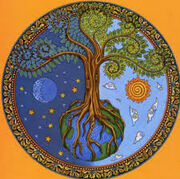а. даљше...
Here in South Asia, traditions concerning the enchanted World Tree or World Axis have taken somewhat
different forms. And
yet,
despite the differences, certain
patterns persist.
The sacred Tree, the vertical World Axis or
stambha, the generous spirit from the
far North: these are all features of pan-Indian culture that derive, most probably, from the very
same source.
It is worth noting that the
European spirit of the North Pole or Christmas also has its structural counterpart in
Indian mythology. In his
aspect as
World Teacher, god
Siva (а заправо... Sanskrit: शिव,
Śiva, lit. the auspicious
one ~
showing or suggesting
that future success is likely ! ) is known as
Dakshina-murti, '
He who faces the South'. But Lord Siva
has five faces, and for
all of them to be facing southward he would
have to position himself at the North Pole,
where every direction is south, leading away from the extreme limit of the North Pole
itself.
... Only further study may tell.
[moi(Фr.):
живо живо]
б. The Slavic version of Wotan
Woda (the
Germanic Wotan-Odin) was worshipped as a god of war and
leadership, in relation to the Slavic verb *
voditi, "to lead". He was also associated with
rune wisdom and with
Vid (Svetovid), as the
supreme God, the "
moving force behind all things";
[39] runes were called
vitha by the West Slavs, which is a genetive of *
vid or *
vit meaning "
image" or "
side", "facet" (referring to the
multifaceted essence of the supreme God).
[168] 15
...
...
conclusion
...
Probably the Slavic language seems to have been (oh please, also is  a champion in preserving the symbolism of the “vitha” (runic symbols).
[
a champion in preserving the symbolism of the “vitha” (runic symbols).
[moi: видвид! у
увид]
в. Quetzalcoatl, Kukulkan, Viracocha, Votan, Gucumatz
1.
Although the traditions from the different Indian groups regarding the “Bearded God” do not agree in every detail, there being a variety of versions, yet in the principal points these Indian traditions, from Canada to Chile, have a close resemblance to one another.
...
The Feathered Serpent God is one of the great mysteries of many ancient cultures. He was called Quetzalcoatl by the Aztecs, Viracocha by the Incas, Kukulkan by the Mayas, Gucumatz in Central America, Votan in Palenque, and Zamna in Izamal.
[moi: слика из учебника. тражи се Руја from White Паланqa ]
2.
Quetzalcoatl's name translates to
“plumed serpent”. Fray Juan Torquemada, the Franciscan missioner, who collected traditions about Quetzalcoatl from the natives of Old Mexico, says:
“Quetzalcoatl had blonde hair, and wore a black robe sewn with little crosses of red color.”
He wears a
headdress of quetzal feathers and a
conch on his chest, a symbol of the wind god; he
carries a curved baton, the
scepter of
the seven stars or constellations. Behind him are the pyramids of the Sun and Moon in the city of Teotihuacan, the great political and religious center of pre-Hispanic Mexico.
[moi:
бело звезда,
рухо ноћи.
где ће сунце проћи
]
3.
The original name for
Viracocha was Kon-Tiki or Illa-Tiki, which means Sun-Tiki or Fire-Tiki. Kon-Tiki was high priest and sun-king of these legendary “white men” who left enormous ruins on the shores of Lake Titicaca.
...
They had a battle on an island in Lake Titicaca, and the fair race was massacred. However, Kon-Tiki and his closest companions managed to escape and later arrived on the Pacific coast.
...
The legend ends with
Kon-Tiki and his companions disappearing westward out to sea.
[moi
:
вар, свар, свод,
кочија vseposod
,
кон(ац), ила, сила,
солнце, тока... и тика и така
dan na noč
daleč krači proč
v noč]
[минуајл самуер ин америка: икскјузми. кендер, куддер рили стилби ени ифс орс ендс енд батс əбаутит?]

 a champion in preserving the symbolism of the “vitha” (runic symbols).
a champion in preserving the symbolism of the “vitha” (runic symbols).